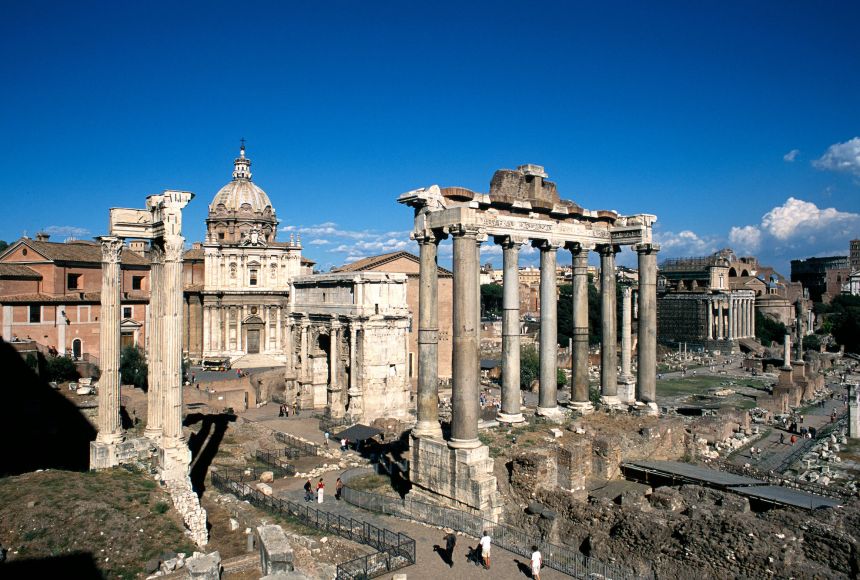In 509 B.C.E., Romans overthrew the last Etruscan king who ruled over them and founded the Roman Republic. The city's first government was a representative democracy. Initially, Rome's wealthiest families, the patricians, had all the power and only they could hold political or religious offices. Every other free Roman citizen (who only could be free, adult males.) was a plebeian, and this group had very little power in Rome. The only ones with less power were enslaved people. Over a period of nearly 200 years, the plebeians fought for and gained power within the government.
Running the Republic
At the heart of the Roman Republic was the Senate, the sole governing body. Although the Senate did not formally make laws, its members had prestige, which gave the Senate great influence over Rome's law-making bodies.
The Senate lasted as the sole governing body of the Republic for only a brief time, from 509 B.C.E. until 494 B.C.E. In that year, a strike orchestrated by the plebeians resulted in the establishment of the Concilium Plebis, or the Council of the Plebs. It gave the plebeians a voice in the government, and new legislative bodies were formed. Called assemblies, these legislative bodies shared power.
A body called the Comitia Centuriata decided about war, passed laws, elected magistrates, considered appeals of capital convictions, and conducted foreign relations.
The Plebeians Gain more Power
The body called the Concilium Plebis elected its own officials and passed laws for the plebeian class. In 287 B.C.E., it gained the power to make laws binding for the entire Roman community, patrician as well as plebeian.
The Comitia Tributa, made up of tribal assemblies, was open to all citizens. It elected minor officials and approved legislative decisions often on local matters. It wielded some judicial power, but could only levy fines rather than sentence criminals to death.
Leading the republic were two consuls who were elected by the legislative assemblies. They served terms of one year. Their responsibilities were to preside over the Roman Senate and command the Roman military. Though their power was somewhat limited, the consuls were effectively the heads of state.
Centuries of Strength, then Struggle
The republic stood strong for several centuries. However, as Rome's power and territory expanded, internal conflicts began to emerge as citizens and families struggled for power. For example, in the first century B.C.E., the famous Roman orator Marcus Cicero uncovered a plot to overthrow the Roman government. Some citizens pushed for reforms to help the poor. Ultimately, factions emerged, which were loyal to either the patrician or plebeian classes or to a specific military general. A series of civil wars followed, which tore apart the Republic. During these civil wars, a prominent general and statesman named Julius Caesar began gaining significant power. He commanded the loyalty of the soldiers in his army and became wealthy after conquering the province of Gaul, a large area in what is now Western Europe.
The Senate became fearful of Caesar's power and demanded he give up command of his army and return to Rome as a private citizen. Caesar refused, instead marching his army south directly into Rome. As a result, another civil war erupted between Caesar and his chief political rival, Pompey. Caesar emerged victorious and was named dictator for life. Other leaders within the republic feared Caesar would become a tyrant. To prevent this, a group of senators conspired and assassinated him. In response to Caesar's death, his nephew and heir Augustus defeated the conspirators and soon became the first Roman emperor.
The Reign of the Emperor Augustus
During the Roman Empire, power became centralized, and the emperor held the most power. For example, under Augustus's reign, emperors gained the ability to introduce and veto laws, as well as command the army. No citizen could hold office without the emperor's consent. As a result, the popular assemblies of the Roman Republic became less important and lost power.
The Senate survived, but primarily to legitimize the emperor's rule. The powers given to the emperor still formally came from the Senate. The Senate could declare an emperor to be an enemy of the state, or following an emperor's removal or death, the Senate could officially wipe the record of his reign from official history.
At the time of Augustus's reign, the Roman Empire controlled the Italian peninsula, established North African colonies and controlled large swaths of territory in Spain and Western Europe. Under the later Imperial Roman emperors, Roman territory expanded even farther. Rome dominated most of the European continent, including Britain and major areas of modern-day Eastern Europe.
Wealth, Power ... then Downfall
This expansion brought great wealth, power, and prestige to Rome, but ultimately helped bring about its downfall. The cost of maintaining the vast empire was heavy and it came under increasing attack from foreign groups. Emperors attempted to solve these problems through internal reforms.
The emperor Diocletian split the Roman Empire into a western half and an eastern half in an attempt to make the empire easier to control. Ultimately the two halves came into conflict, and the weakened empire collapsed.
In C.E. 476, the last of the western Roman emperors, Romulus Augustulus, was dethroned. Nevertheless, the eastern half of the Roman Empire, which we know as the Byzantine Empire, would last another thousand years until it fell to the Ottoman Turks in C.E. 1453.

